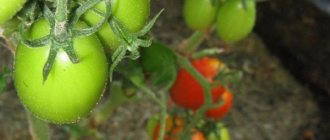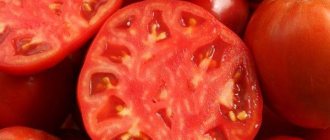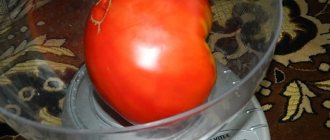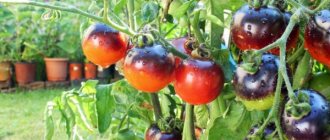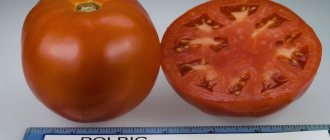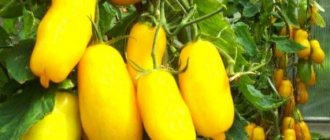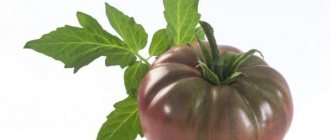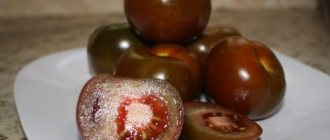Pink Siberian Tiger tomato: characteristics and description of the variety, photo
The Siberian Tiger tomato is a variety with a rare color of American origin. The culture was developed by Mark McCaslin. The tomato, which also goes by the name Siberian Tiger, is obtained by crossing the OSU Blue and King Beauty varieties. It is not included in the Russian State Register of selection achievements approved for cultivation.
Description of Siberian Tiger variety tomatoes
The Siberian Tiger tomato is a large-fruited variety with a striped color. In the southern regions it is suitable for growing in open ground. In the North, planting in greenhouses is recommended.
Tall stems with heavy tomatoes are grown with a garter
The ripening period is average. The leaves are green and large. The bush type is indeterminate, which means unlimited growing season. For such plants, the top of the stem is forcibly pinched a few weeks before the end of the growing season. This allows the growth of the vegetative part to be completed and forces to be directed towards fruit ripening.
For productive cultivation of the crop, several stems are left, other side shoots that appear are promptly removed.
The Siberian Tiger variety is not included in the official sale. Seeds are purchased from foreign companies or from domestic amateur breeders. In the future, the species can be reproduced from its own seeds.
Description of fruits
Tomatoes are round, but can be irregularly shaped or fused. The ribbing is medium. On the lower part of the bush, the fruits grow weighing 300 g, becoming smaller towards the top, on average - 150-200 g.
The pulp of the fruit is sugary, juicy, dense
When unripe, tomatoes are green in color with darker stripes extending from the stem. When ripe, they turn dark red and the stripes turn dark purple. The coloring resembles a tiger's coloring, but is unstable, sometimes the stripes are not clearly visible and the dark color merges into one spot. The streaks are more pronounced when grown in open ground and in intense sunlight.
A special feature of the variety is the sweet taste of the fruit. It contains fruity shades that leave a long and pleasant aftertaste. The characteristic tomato sourness is also not noticeable.
Inside, the tomatoes are multi-celled, the flesh is red with a large number of small seeds. The skin is thin and prone to cracking.
Characteristics of the Siberian Tiger tomato
The Siberian Tiger tomato is tall, the bush grows in 2-3 stems. To avoid the growth of stepchildren, they are removed at least once a week, leaving small stumps so that the growth of shoots does not resume. During the growing season, the leaves under the inflorescences are also gradually removed. This ensures good ventilation of the plants.
One bush grows up to seven clusters of 4-6 tomatoes each. Depending on the growing region, the ovaries are rationed so that the remaining fruits have time to ripen. The Siberian Tiger variety is rare, obtained from crossing two different types of tomatoes. It is characterized by unstable characteristics, especially in relation to the shape and color of the fruit.
Siberian Tiger tomato yield and fruiting
The Siberian Tiger variety is classified as medium-yielding. About 2 kg of fruits are harvested from one bush in greenhouse conditions. It begins to bear fruit 3.5 months from the sowing date. The yield is influenced by correct formation, normalization of the amount of ovary, as well as soil fertility and light intensity.
Area of application of fruits
The Siberian Tiger tomato has a salad purpose. Due to their color and longer ripening time, the fruits accumulate many useful substances. The taste is similar to fruit; tomatoes are included in children's diets. Due to their thin skin and large size, tomatoes are not suitable for canning.
Resistance to diseases and pests
The Siberian Tiger tomato has high immunity to diseases. Therefore, it can be cultivated without the use of potent plant protection products. Depending on the growing region and weather conditions, preventive spraying with fungicides is carried out from one to several times a month.
Advantages and disadvantages of the variety
The Siberian Tiger tomato is an original variety with an exotic color. The crop is also grown for its sweet taste, close to fruity.
Care
Tomato Bugai
It is believed that you can increase productivity by removing leaves, but you should not abuse this, otherwise the effect will be completely opposite. Due to the leaves, the fruits are saturated with vitamins and other beneficial substances. Thus, only diseased, low-quality leaves, as well as those located under stems with ripe fruits, need to be broken off. Leaves are removed gradually, in the amount of 3-4 per week.
Note! Removing part of the leaves in the lower part of the stem (up to 1/3 of the height) ensures good ventilation of the plantation, which helps prevent various diseases in tomatoes.
To make the setting process more active, it is recommended to spray the tomatoes with a solution of boric acid.
You should not water the plant frequently. One high-quality watering 2 times a week is enough. The soil must be loosened and the tomatoes hilled.
If tomatoes are grown in greenhouse conditions, the air temperature should not exceed 32 °C. Exceeding this norm will cause the plants to wither. It is necessary to constantly monitor temperature indicators and ventilate the room as needed.
Wilting tomato
Criteria for choosing planting material
The most important criterion is the choice of seeds. It is better to buy them in specialized stores. As a rule, such seeds have good germination. The description and characteristics of tomatoes can be read on the packets of seeds. From there we will find out whether it is necessary to grow it in open or closed ground, as well as the growth period and size of the fruit.
The container for seedlings can be varied, from disposable plastic containers to specially prepared seedlings. The choice depends on preferences and financial capabilities. You can sow in sour cream or yogurt cups, or in special boxes with specific heat supply functions and equipped with trays.
The choice of soil is the basic criterion for excellent seedlings. Here are a few examples: universal soil, peat and peat tablets. The latter of which are popular. Soil from your own plot is also suitable, but it practically does not contain the required number of minerals and trace elements for the necessary healthy growth and further development of the plant. “Store” soil is subjected to special treatment against fungi and diseases. Thanks to this, we avoid maximum losses during germination.
Tomato seedlings
Then we decide by what properties we will choose plants:
- Maturing period;
- The taste of the fruit and its use in everyday life (canning, salad, juice, confiture);
- Bush height;
- And of course, the yield and weight of tomatoes.
Characteristics of tomato
When planting a tomato variety Siberian Tiger in the southern zone, you can get an excellent harvest in open ground. In middle and northern latitudes, it is better to grow this tomato in greenhouses and film shelters, since its fruits do not tolerate cold temperatures well.
Productivity and fruiting
The Siberian Tiger variety is mid-season - technical maturity occurs 110-120 days after emergence. With the right agricultural technology, you can achieve good yields: from 1 bush - 3-4 kg, and from 1 sq. m - up to 12 kg.
Recommendations for increasing the yield of Siberian Tiger tomatoes.
Tomatoes love fertile, light soil. The best predecessors are beans, carrots, cucumbers and cabbage. It is not recommended to plant tomatoes in the same place earlier than after 2-3 years. When growing crops in a greenhouse, it is necessary to monitor the temperature regime. Temperatures exceeding plus 32 can be detrimental to tomatoes
It is also important not to forget about ventilation. Fresh humus cannot be used. This can increase the growth of stepsons and large leaves, and the stem, on the contrary, will become thinner
The fruits will set worse and grow slower. It is necessary to remove the stepsons in a timely manner, otherwise part of the harvest will be lost. Tomatoes do not like excess moisture, so do not overdo it with watering. To increase the ovary, the bushes can be sprayed with boric acid (0.02% solution). Do not overuse leaf breaking to increase yield. Without these actions, you can get the opposite effect. After all, the leaves provide the plant with useful substances and vitamins. Only diseased and damaged leaves should be removed from tomatoes.
Advice! As soon as all the fruits on the first cluster are ripe, you can cut off all the leaves above it. This should be done throughout the growing season. But it is not recommended to remove more than 3-4 leaves per week on one tomato bush.
Area of application of fruits
Tomatoes of the Siberian Tiger variety can be consumed both fresh and for preparing a variety of dishes. From ripe tomatoes it is easy to prepare canned salads for the winter, lecho, ketchups, sauces, adjika, Spanish gazpacho soup, tomato paste and juice. You can add them to salads, stews, soups, pizza. Due to the high acid content in fruits, they are harmoniously combined with meat dishes, both fresh (as a side dish) and in the form of sauces and marinades.
Resistance to diseases and pests
The Siberian tiger has strong immunity to the development of many viral, infectious and bacterial diseases. The bushes are not subject to attack by various pests. If you follow all the recommendations for growing and caring for tomatoes of this variety, you don’t have to worry about any problems with yield.
Advantages and disadvantages of the variety
Based on the description of the variety and reviews from gardeners about the yield, we can highlight both the advantages of the Siberian Tiger tomato (photo) and its disadvantages.
Advantages of tomato:
- exotic coloring;
- excellent and unusual taste characteristics;
- can be grown both indoors and outdoors;
- large weight of fruits;
- a large number of ovaries are formed;
- fruits are not prone to cracking when watering;
- tomatoes hold well on the stalk when overripe;
- resistance to cracking when overripe;
- versatility of fruits;
- high yield.
Every vegetable has its downsides. This variety is no exception. Disadvantages of the Siberian Tiger tomato:
the plant is tall, so its growth must be restrained by pinching the top of the main stem; the need to tie up not only the stems, but also the bunches; needs pinching, since it is recommended to form the plant into only 1-2 stems, so as not to overload; the fruits have thin skin, so the variety is not suitable for whole-fruit canning; The Siberian tiger is not very suitable for transportation
Delicate skin is severely damaged from any physical impact, so they should be placed in boxes carefully and neatly, in one row; fresh harvested crops are not stored for a long time; in a warm climate zone, all clusters ripen even when grown in open ground. In other latitudes, it is preferable to grow this variety in greenhouses.
Fruit
They are very beautiful! In the photo I saw them completely striped, really looking like the skin of a tiger or a St. George’s ribbon. I didn’t grow any of these, but there was a pleasant play of dark red, pinkish-scarlet and purple shades.
Tomatoes are ribbed, roundish in shape. The skin is quite thin and I like it - I enjoyed cutting them into salads. And the family devoured them, too, with pleasure.
These tomatoes have a fairly high acid content, so I was happy to make vegetable kebabs from them, add them to meat, and cook tomato sauce. I made canned food. Quite!
The sunny the place where you planted your “tiger cubs”, the more beautiful the color will be. They love the sun very much. The weight of the tomato ranges from 150 to 300 grams. If you do everything correctly and take good care of the bushes, you will get a harvest of 3.5 kg per bush.
What does "correct" mean? I'll explain now:
- Don’t get too carried away with breaking off the leaves: the leaves provide the fruits with everything useful and nutritious, so don’t harm your tomatoes with excessive zeal.
- Don't forget to ventilate the greenhouse. Even such heat-loving “Americans” do not like excessive heat - it should not be more than 32 degrees.
- Be careful with fresh manure - instead of a large harvest of fruits, you will get a huge harvest of leaves and shoots. But it’s good if you collect a kilogram of fruit.
- The best “predecessors” of the variety are legumes, cucumbers, cabbage, and carrots.
- Don't forget to stepchild! Otherwise, you will have a lush jungle with stunted fruits: everything will turn into greenery.
- Do not flood the bushes - this variety does not like excessive moisture.
- A little secret: when all the fruits on the first cluster are ripe, cut off all the leaves above it. Do this throughout the entire ripening period. But do not tear more than 4 leaves on one bush per week.
Growing seedlings
For planting, you need to prepare convenient containers; you can purchase ready-made soil or make it yourself by mixing soil from the site and humus in equal parts, you can also add a little river sand to improve the structure of the soil and wood ash, which perfectly fights blackleg.
The soil and seeds are disinfected before sowing, using a pink solution of manganese, its temperature should be 100 degrees. After processing, the container with soil is covered with thick cloth. Preparing seeds involves checking for similarity; for this they are placed in a saline solution; any seeds that float are considered unsuitable. Those remaining lying on the bottom are disinfected, washed and dried to a flowable state.
Important! It is not recommended to soak and germinate the seeds of this variety. Dry seeds are sown in moist soil to a depth of 1 cm, covered with cellophane on top and placed in a warm place; thanks to the greenhouse effect, the seeds germinate faster, usually within 4-7 days
After seedlings appear on the surface of the soil, the cover is removed, the plants are watered, and the container with seedlings is placed in a well-lit place, the temperature is reduced by several degrees
Dry seeds are sown in moist soil to a depth of 1 cm, covered with cellophane on top and placed in a warm place; thanks to the greenhouse effect, the seeds germinate faster, usually within 4-7 days. After the seedlings appear on the surface of the soil, the shelter is removed, the plants are watered, and the container with seedlings is placed in a well-lit place, the temperature is reduced by several degrees.
When 2-3 leaves appear on the plant, you can pick them into separate containers. Before planting, the seedlings are taken out into the fresh air for several days, thus hardening occurs. The bluish tint of the stems indicates readiness for transplanting into the soil.
Diseases and pests
This variety has good immunity to common tomato diseases. If the recommended care is followed, the plants should not be susceptible to disease. If there is not enough light for the plants in the greenhouse or if watering is not maintained, the leaves of the bushes may be affected by powdery mildew.
If aphids or whiteflies occur, a solution called “Confidor” is used. They should spray the plants. To do this, 1 ml of the drug is diluted in water; the resulting solution is enough to treat 100 m2.
In order to prevent rotting of the root system, the soil must be loosened periodically. Thanks to this, the tomatoes will not only not get sick, but also produce a tastier and higher yield.
You may be interested in: Dates for planting tomato seedlings in open ground and greenhouses according to the garden calendar Favorable days for planting tomatoes for seedlings in 2021 according to the lunar sowing calendar Favorable days for picking tomatoes in 2021 after germination: timing of picking tomato seedlings in the table by day
Care
Thorough irrigation is carried out only after transplantation, then you should adhere to the drip irrigation method, uniform. Water is directed under low pressure under the stem so that it reaches the root system. Watering is preferably done in the morning, which allows moisture to be absorbed until night. This prevents the tomato bushes from experiencing a stress response to possible freezing in moist, cool soil.
In terms of fertilizing, it is enough to alternate minerals and organic matter. But do not ignore symptoms indicating a deficiency of certain compounds
Sometimes it is necessary to focus on magnesium and calcium in order to achieve balanced development of the plant and avoid diseases and reduced ovary production. Gardeners should not forget about mulch, which may be needed in cold or hot conditions
Tomato Heavyweight of Siberia - description
The variety is early, the first fruits are ready for consumption 3 months after germination. This is one of the fastest ripening varieties among beef tomatoes.
Characteristics of the bush
The height of the plant is 40-50 cm, in protected soil the stem can stretch up to 80 cm. Tomato stems are strong, but they are not able to support the weight of the fruit, so a garter to a support is necessary.
The foliage of the bush is average. The leaves are light green, small in size, slightly pubescent.
Fruits and yield
Each plant produces 2-3 clusters of fruit. Tomatoes are heart-shaped or bast-shaped, with a dense pink-raspberry shell. The inside of the fruit is multi-chambered, with a high pulp content and a small amount of juice. The taste is sweet, rich.
The average weight of the fruit is 200-280 g, the first tomatoes on the bunch reach a weight of 450 g. If no more than 3-5 fruits are left on the bush, the weight of each can be 700-800 g.
The total yield of the plant is 2.5-3 kg.
Immunity to disease
The heavyweight of Siberia has innate immunity to fusarium and TMV. It does not suffer from temperature changes and tolerates high air humidity.
Agricultural technology varieties
As indicated in the characteristics and description of the variety, the Siberian Tiger tomato can be grown in any soil, depending on the climatic conditions of the region.
Preparing seedlings
- Tomato seeds of this variety are planted in prepared soil in containers convenient for every gardener. The soil can be purchased at the store (it is completely balanced) or you can prepare it yourself by taking equal parts of soil from the garden bed, compost or humus. To improve the soil structure, add a little sand, and to combat blackleg, add wood ash.
- The soil and container must be disinfected. As a rule, boiling water with potassium permanganate added to it is used. The pink solution is poured onto the ground and covered with a thick cloth to improve the effect of the treatment.
- Tomato seeds also need to be prepared. They are first poured into salt water to select frail and immature specimens (they will float to the top). Then they are washed in warm water and placed in a pink solution of potassium permanganate for about 15 minutes. Wash again and dry to a free-flowing state. It is not recommended to soak and germinate seeds of the Siberian Tiger tomato variety.
- Dry seeds are placed in sowing containers to a depth of no more than 1.5 cm (ideally 8-9 mm) in moist soil. Cover the top of the container with a piece of cellophane to speed up germination. Before germination, the box is placed in a warm, lighted window. Thanks to the greenhouse effect, tomato seeds germinate within 4-5 days. The film is removed and the temperature is reduced slightly so that the seedlings do not stretch. To save space on the windowsill, seeds can be grown in a snail. And the video below will help those gardeners who are using this method of planting tomatoes for the first time to cope with the work:
- When two or three true leaves appear, pick them into separate cups with a volume of at least 500 ml. In smaller containers, plants will feel uncomfortable, which will negatively affect the seedlings.
- Before planting in a permanent place, glasses with Siberian Tiger tomatoes are taken out into the fresh air for hardening. Tomatoes that are ready for planting will have a bluish tint to their stems.
Planting and care in the ground
The land for tomatoes is prepared in the fall. It is fertilized and dug up. If for some reason the work was not completed, then this can be done in the spring.
After preparing the holes, each is spilled with a pink solution of potassium permanganate (boiling water), and a handful of wood ash is added.
The distance between plants is at least 50 cm, because only 4 tomatoes are planted per square meter. The seedlings should not be deeply buried, otherwise the growing season will be prolonged. The fruits will ripen about two weeks later.
Attention! Thickened plantings of tomatoes lead to crop loss, since the plants will not have enough light and air. Immediately after planting, seedlings are watered and the soil is mulched.
Be sure to tear off the lower leaves and stepsons before the first fork. Form a bush in a greenhouse with one or two stems. In open ground you can leave 2-3. Subsequently, all the stepsons are removed and the leaves under the clusters are pinched. This will provide light access and facilitate air circulation
Immediately after planting, the seedlings are watered and the soil is mulched. Be sure to tear off the lower leaves and stepsons before the first fork. Form a bush in a greenhouse with one or two stems. In open ground you can leave 2-3. Subsequently, all the stepsons are removed and the leaves under the clusters are pinched. This will provide light access and facilitate air circulation.
Further care for Siberian Tiger tomatoes comes down to traditional actions:
- watering, loosening, weeding;
- feeding tomatoes;
- preventive measures against diseases.
Siberian Tiger tomatoes are recommended to be fed with organic fertilizers.
When the bush grows to the ceiling of the greenhouse, the stems are pinched. This operation allows you to redistribute nutrients that will begin to work on the formation and ripening of the crop.
- https://agrognom.ru/vegetables/tomatoes/tomat-rozovyj-sibirskij-tigr.html
- https://7ogorod.ru/pomidory/tomat-amurskij-tigr.html
- https://dachamechty.ru/tomat/sort/sibirskij-tigr.html
- https://dachamechty.ru/tomat/uborka/amurskij-tigr.html
- https://dacha365.net/ogorod/ovoshhi/tomaty/sibirskij-tigr-otzyvy-foto.html
- https://fermilon.ru/sad-i-ogorod/ovoshhi/tomat-rozovyj-sibirskij-tigr.html
- https://sornyakov.net/vegetables/tomat-sibirskij-tigr.html
Landing
Suitable for growing both under film or in a greenhouse (recommended for the middle zone and Siberia), and in open ground.
Growing seedlings
Seeds are sown 45-50 days before seedlings are planted in the ground (late March - early April). It grows well in the ground without additional fertilizing, but in short daylight conditions it is better to additionally illuminate the sprouts, extending the illumination period to 12-15 hours.
Landing in the ground
It is recommended to maintain a distance between bushes of 40x50 cm, but if there is enough lighting in the selected area, you can plant more often, 30x40 cm. The choice of distance depends on the method of forming the bush. With 2 stems the yield per bush will be less, with 3 stems the yield per square meter will be less. In greenhouses, molding into 3 stems is not used.
Get to work!
So, all the stages of growing a variety are detailed. I bought the seeds from a local agricultural company. The package said “for open ground,” but I only planted it in a greenhouse.
I planted seeds for seedlings at the end of March. I bought land in a store. Although it was possible, of course, to prepare it yourself, as last year, according to the principle: humus, compost, earth equally. I added a little more river sand and ash from the country stove. But for some reason I’m not very keen on exploits lately.
The seedling container was doused with boiling water and a weak solution of manganese. I kept the soil in the oven at 60 degrees. Of course, I also processed the seeds: I poured them into salted water for a quarter of an hour.
Several seeds floated to the surface, I removed them - that means they were unusable. Then I washed it and kept it in manganese for a while and dried it. There is no need to soak for a long time and germinate the seeds of the “Siberian Tiger” variety - this method is absolutely not suitable for them.
Then I planted the seeds in moist soil in small containers. Not too deep: a centimeter and a half. I placed the containers on a large windowsill on the sunny side. Then she took it to the greenhouse when the sprouts appeared. The temperature there was ideal for them, because the spring this year was not cold, but good.
I placed several containers in a long tray with a lid and covered them. This is how early shoots are achieved. As soon as the first two leaves hatched, I planted the seedlings in separate peat pots.
Reviews
Evgeniy 30 years old
My sister brought the seeds and highly praised the “Siberian Tiger”. I sowed the seeds in March, transplanted them into a greenhouse in mid-May, all the bushes were the same, they didn’t hurt. Already in July, the first tomatoes began to ripen; I, of course, saw the picture on the packaging, but I did not actually expect such a result. The tomatoes are large, tasty, and ordinary everyday salads looked like festive dishes. They closed it with juice and lecho, although not very much. The yield from 1 m2 is approximately 8 kg. I am satisfied with the varietal qualities, if I find it I will buy more for the next season.
Marina 54 years old
I saw these unusual fruits at my neighbor’s house and they simply fascinated me. I decided to plant myself for the next season. It’s hard to find seeds, I’ve gone to more than one store so far and found them on sale. The germination rate, of course, is not the highest, but even this did not diminish my enthusiasm. The bushes grew strong and were transplanted into a greenhouse at the end of May. The yield is average, but the tomatoes are very tasty with a distinct fruity smell and aroused the interest even of the grandchildren. Of course, I read that you shouldn’t collect seeds from the harvest, but still, I want to experiment, in case I can’t find the seeds, I’ll at least try to plant these.
Tomato Amur Tiger. Results and my conclusions
I will summarize the testing results and share my impressions of the Amur Tiger tomato.
Since man acquired the ability to plow,
He felt the desire to decorate the house and yard
and began to plant around himself for beauty
Trees and flowers to your liking. Jacques DeLisle
Perhaps I will not be mistaken if I say that every summer resident dreams of growing something unusual, original and beautiful in his own way on his land. And if it is also delicious, then it is almost impossible to resist the temptation to acquire a curiosity. So I couldn’t pass by such a charming and very appetizing tomato. The name of this variety alone is worth it - Amur Tiger.
From the description of the variety: “A unique variety for film greenhouses and open ground. Mid-season, from germination to fruiting 108-112 days. The plants are indeterminate, 1.5-2 m high. The fruits are fleshy, aromatic, weighing 150-200 g (individually up to 400 g). The taste is excellent. Tomatoes are great in salads. The striped color remains during canning. Productivity 11-12 kg/m2" Sowing
At a temperature of 22-25 degrees Celsius, the first shoot loops appeared on the fourth day.
Seedling development and care:
Immediately after the first shoots appeared, I changed the temperature of the seedlings, lowering it slightly to +20 degrees during the day and +18 degrees at night.
In mid-March, the true leaves began to appear.
Beautiful, fluffy leaves filled the room with the aroma of summer. All care consisted of watering and loosening the soil with a toothpick after watering, as well as illuminating the plants with a phytolight from 7 a.m. to 10 p.m.
When the tomato bushes were a month old, I transferred the seedlings into liter containers. By this day, the Amur tiger had 5-6 true leaves and a well-developed root system
Since April 28, the tomato bushes had to get used to the harsh truth of life: first, go through the hardening procedure under the crown of a pine tree, and then in mid-May they moved to the greenhouse and waited for care from me only on weekends. The first buds appeared on the plants. The first inflorescence is formed above the 6th leaf.
On May 20, the first flowers bloomed. During flowering, I fed the bushes and mulched the beds with mowed grass.
Then ovaries formed, which captivated the eye with their striped beauty.
But, to my great regret, not all flowers were destined to turn into fruits. Perhaps the Amur tiger did not like my spartan conditions, and he dropped some of the flower clusters, which significantly affected the yield.
During the summer, I watered the tomato bushes with well water heated in the sun, mulched the bed, and fed it with ash and herbal infusions.
On July 31, I tasted the first ripened fruits. Then harvested on August 6, August 16 and September 2.
Taste and product characteristics:
The average fruit weight is 159-200 g. The largest fruit, in my case, weighed 295 g.
The fruit is flat-round in shape with a striped color of medium-thick skin. The pulp is pleasant to the taste, aromatic, juicy, burgundy in color.
Results and impressions:
Excellent seed germination
Bush height 1.5-2 m
Beautiful appearance of fruits
High taste qualities
Productivity 11-12 kg/m2
Disease resistance Result
The variety is susceptible to weather and maintenance conditions, which is reflected in the shedding of flower clusters and ovaries.
Bush height more than 2 m
The fruits are very attractive in appearance with a beautiful striped skin color
The fruits are tasty and aromatic
2.729 kg per bush or 10.916 kg/m2
The variety is resistant to diseases
Conclusions:
The Amur Tiger tomato showed full compliance with the taste qualities declared by the manufacturer: the tomatoes are tasty, fragrant and beautiful in appearance, look great in salads, and are ideal for making tomato juice.
The metric characteristics are slightly different from those declared by the agricultural company: the tomato bush turned out to be larger than the expected size, the yield was close to the promised (10.916 kg/m2 versus 11-12 kg/m2)
This is where I finish my story about the Amur Tiger tomato and wish everyone rich harvests, good mood, smiles, and an endless fireworks display of sunny optimism.
Thank you very much to the Aelita Agrofirm and the administration of the 7dach site for the fact that, thanks to testing, I became acquainted with minke whales, the taste of which brought a lot of pleasure to adults and children
With gratitude and respect, your Tigger))))
Tomato Amur Tiger. Results and my conclusions
I will summarize the testing results and share my impressions of the Amur Tiger tomato.
Since man acquired the ability to plow,
He felt the desire to decorate the house and yard
and began to plant around himself for beauty
Trees and flowers to your liking. Jacques DeLisle
Perhaps I will not be mistaken if I say that every summer resident dreams of growing something unusual, original and beautiful in his own way on his land. And if it is also delicious, then it is almost impossible to resist the temptation to acquire a curiosity. So I couldn’t pass by such a charming and very appetizing tomato. The name of this variety alone is worth it - Amur Tiger.
From the description of the variety: “A unique variety for film greenhouses and open ground. Mid-season, from germination to fruiting 108-112 days. The plants are indeterminate, 1.5-2 m high. The fruits are fleshy, aromatic, weighing 150-200 g (individually up to 400 g). The taste is excellent. Tomatoes are great in salads. The striped color remains during canning. Productivity 11-12 kg/m2" Sowing
At a temperature of 22-25 degrees Celsius, the first shoot loops appeared on the fourth day.
Seedling development and care:
Immediately after the first shoots appeared, I changed the temperature of the seedlings, lowering it slightly to +20 degrees during the day and +18 degrees at night.
In mid-March, the true leaves began to appear.
Beautiful, fluffy leaves filled the room with the aroma of summer. All care consisted of watering and loosening the soil with a toothpick after watering, as well as illuminating the plants with a phytolight from 7 a.m. to 10 p.m.
When the tomato bushes were a month old, I transferred the seedlings into liter containers. By this day, the Amur tiger had 5-6 true leaves and a well-developed root system
Since April 28, the tomato bushes had to get used to the harsh truth of life: first, go through the hardening procedure under the crown of a pine tree, and then in mid-May they moved to the greenhouse and waited for care from me only on weekends. The first buds appeared on the plants. The first inflorescence is formed above the 6th leaf.
On May 20, the first flowers bloomed. During flowering, I fed the bushes and mulched the beds with mowed grass.
Then ovaries formed, which captivated the eye with their striped beauty.
But, to my great regret, not all flowers were destined to turn into fruits. Perhaps the Amur tiger did not like my spartan conditions, and he dropped some of the flower clusters, which significantly affected the yield.
During the summer, I watered the tomato bushes with well water heated in the sun, mulched the bed, and fed it with ash and herbal infusions.
On July 31, I tasted the first ripened fruits. Then harvested on August 6, August 16 and September 2.
Taste and product characteristics:
The average fruit weight is 159-200 g. The largest fruit, in my case, weighed 295 g.
The fruit is flat-round in shape with a striped color of medium-thick skin. The pulp is pleasant to the taste, aromatic, juicy, burgundy in color.
Results and impressions:
Excellent seed germination
Bush height 1.5-2 m
Beautiful appearance of fruits
High taste qualities
Productivity 11-12 kg/m2
Disease resistance Result
The variety is susceptible to weather and maintenance conditions, which is reflected in the shedding of flower clusters and ovaries.
Bush height more than 2 m
The fruits are very attractive in appearance with a beautiful striped skin color
The fruits are tasty and aromatic
2.729 kg per bush or 10.916 kg/m2
The variety is resistant to diseases
